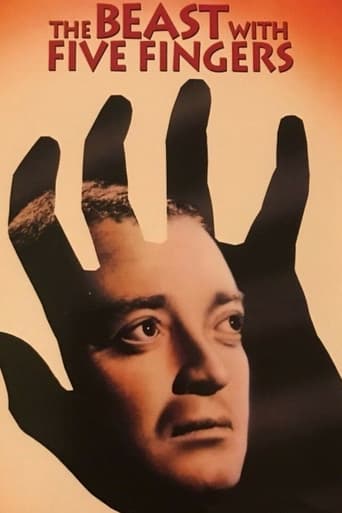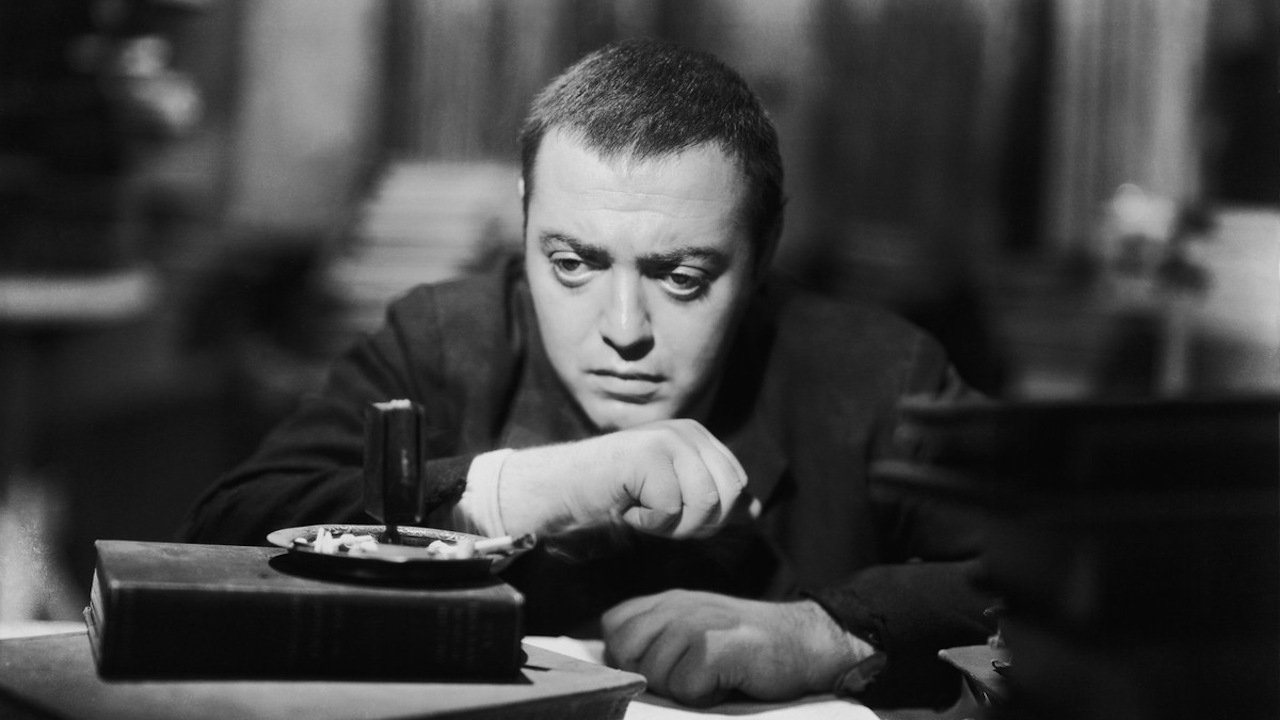JohnHowardReid
Apart from its title, its setting in the library and two or three incidents (the servants quitting, the hand being locked in the safe), the movie, "The Beast With Five Fingers" bears very little relationship to the Harvey story. If anything, the screenplay tells a more spine-chilling tale, and tells it more effectively. In fact, Peter Lorre contributes one of his most dramatically macabre portraits. He receives great support from Victor Francen's chilling study of an eccentric pianist. Some memorable bits from Pedro De Cordoba's surly innkeeper and David Hoffman's slimy lawyer also add to the atmosphere. On the other hand, after his promising opening scene, Robert Alda slips into the hackneyed emotions of a conventional hero. As for Andrea King, whilst she certainly makes an attractive heroine, her acting is not altogether convincing. And then there's J. Carroll Naish who seemingly can't make up his mind whether to play his role for chills or misplaced humor!Fortunately, while he has obviously concentrated less on his players, director Florey has brought the film in with a fair amount of visual style. In fact, in at least two or three instances, Florey's direction is so compellingly inventive, it's impossible to take your eyes from the screen. McGann's masterly special effects are also compellingly realistic, while ever-reliable Max Steiner has contributed a music score as moodily atmospheric as his "Most Dangerous Game" or "King Kong".
sddavis63
I would recommend this film for the performances of the leads more than anything. Peter Lorre, Robert Alda and Andrea King all did very well with their parts. Lorre, as Hilary (personal assistant to disabled but famed pianist Francis Ingram, played by Victor Francen), was really tailor made for this type of film, playing a suspicious and even somewhat creepy character. Alda (as a sort of con artist named Conrad Ryder, whose relationship with Ingram I never really did understand) and King (as Ingram's personal nurse Julie) were both much better known for their television roles than for movies, but both did well with their parts.The story revolves around Ingram, his "friendships" (for lack of a better word) with the three aforementioned characters, and others who become suspicious when Ingram dies in an accident - his wheelchair having fallen down a staircase - and leaves his entire estate to Julie. In the midst of some concerns about the will, Ingram's only two living family members show up and challenge the will. The title then begins to make sense, as what is apparently Ingram's disembodied hand begins a murderous rampage.This worked fairly well as a suspense movie, but I wouldn't call it a "horror" movie. I never believed (well, perhaps I had a shade of doubt for a moment, but it didn't last long) that there was really a disembodied hand on the loose. Clearly, there was another explanation. We just had to wait for it to be revealed. It was a decent enough story. There was nothing spectacular about it, but it's certainly not a failure. It featured some pretty decent special effects (for the time) with the disembodied hand, but it made a huge mistake in the last scene, suddenly trying to be funny, which was out of keeping with the entire story up to that point and which actually left me a bit dry. I didn't see the need for that "humourous" ending - which wasn't that funny anyway, and which was entirely out of place. Still, it's a decent enough movie to watch. (5/10)
calvinnme
... the rest of the show is J.Carrol Naish as the understated but determined Police Commissario Ovidio Castanio, and Victor Francen as Francis Ingram, a paralyzed concert pianist. Together they take a script that drags in spots and make it memorable with some great performances. The opening scene is rather misleading as it makes you think that this film is going to be about petty con man Conrad Ryler (Robert Alda) and the police official that recognizes but looks the other way at his somewhat crooked ways (J. Carroll Naish). It is not.The story quickly moves to the estate of invalid pianist Francis Ingram, his body completely paralyzed save his left hand, being cared for by his nurse Julie (Andrea King). Francis is obviously in love with her, but realizes the two could never have a real relationship. However, this doesn't prevent him from being horribly jealous of her. He has an eccentric private secretary (Peter Lorre as Hilary) who doesn't seem to be doing any work at all for Francis, instead he spends all of his time studying astrology. This is OK with Francis as he is busy studying Julie. All of this Gothic atmosphere leads up to Francis accidentally falling down the stairs to his death, his greedy estranged relatives arriving from England, and their discovery that Francis has written his nephew out of the will and given everything to his nurse Julie. True to the form of the one percent, these greedy relatives are not good sports about this and threaten to break the will even if they have to accuse Julie of murder - and all with the help of Francis' own lawyer who drew up the will in the first place - for a cut of the estate of course. The piano, locked since Francis' death, is heard to play at night yet nobody is around and the next morning the lawyer is found strangled dead. Later the greedy nephew almost meets the same fate. Some investigation by the police finds that Francis' one good hand is missing from his body. Is Francis' disembodied hand going about wreaking vigilante justice on those that are wronging him after death? Of course not! After all, this isn't Universal Studios, this is Warner Brothers, and there is a reasonable explanation. I'll let you watch and find out what that is.The last scene had me quite upset. Julie just signs over the estate to the greedy relatives and walks away from the whole thing, penniless. At least "the hand" could have done away with the two greedy relatives and let kind Julie keep what Francis intended her to have. I guess in the production code era, murder is wrong but greed is good.
MARIO GAUCI
This proved to be Warners' sole foray into the horror genre during the 1940s after a handful of variable efforts made in the previous decade (the John Barrymore vehicles SVENGALI and THE MAD GENIUS {both 1931}, the two-strip Technicolor showcases DOCTOR X {1932} and MYSTERY OF THE WAX MUSEUM {1933}, both featuring stalwarts Lionel Atwill and Fay Wray, and the black-and-white sequel THE RETURN OF DR. X {1939}, with an ill-at-ease Humphrey Bogart).Though third-billed after romantic leads Robert Alda and Andrea King, Peter Lorre was obviously the star here – his own third stab at the popular form, following MAD LOVE (1935; produced by MGM) and THE FACE BEHIND THE MASK (1941; a Columbia picture also directed by Florey), and to which he would briefly return towards the end of his career at AIP. Lorre, in fact, was a staple of Warner's typical noir-ish style of the era (in which THE BEAST WITH FIVE FINGERS itself is shot) – beginning with the classic THE MALTESE FALCON (1941) and continuing in his other films with either Humphrey Bogart or Sydney Greenstreet; actually, this was his only solo vehicle at that studio and, like the actor's earlier afore-mentioned genre turns, he not only carries it with aplomb but delivers a memorable performance.While the film is ideal Halloween fare (I watched a number of horror-related stuff throughout October in conjunction with my ongoing Luis Bunuel retrospective), it also forms part of that tribute to the Spanish Surrealist master because he claimed to have supplied Warners – while employed there during his American exile – with an idea for a motion picture about a rampaging disembodied hand, which they rejected at the time but eventually found itself on the screen anyway (though the story was attributed to somebody else)!; that said, he would have his revenge by 'appropriating' the device for himself – using it within a surreal context – for one of his major works i.e. THE EXTERMINATING ANGEL (1962), with the result being clearly much superior to its 'inspiration'! For the record, other 'appearances' of the titular 'monster' are to be found in: THE WITCH'S MIRROR (1960), a cult item emanating from Mexico; the low-budgeter THE CRAWLING HAND (1963); the Amicus horror compendium DR. TERROR'S HOUSE OF HORRORS (1965); the 1960s TV series and 1990s film versions of THE ADDAMS FAMILY; the Oliver Stone-Michael Caine dud THE HAND (1981); and, most recently, TRICK 'R TREAT (2007; which I have just watched).To get back to the subject at hand (no pun intended), the phoney European setting of THE BEAST WITH FIVE FINGERS seems to have been influenced by that seen in the second phase of Universal horrors; even so, a good deal of the action takes place inside a sprawling villa – which, ironically, not only looks back to the 'animated' mansion from the French Poe adaptation THE FALL OF THE HOUSE OF USHER (1928; on which Bunuel himself had served as Assistant Director) but forward to the endless spate of Mexi-Horrors often revolving around a gloomy hacienda (let's not forget that Bunuel spent almost 20 years rebuilding his film-making career in Mexico). Anyway, we get plenty of brooding atmosphere here – with the special effects dealing with the murderous limb being reasonably effective for their time; still, while the Max Steiner score was appropriately moody (particularly the main theme that, for plot purposes, recurs throughout), I was a bit distressed by how similar it sounded to the same composer's distinctive work on the Howard Hawks/Humphrey Bogart noir masterpiece THE BIG SLEEP which, though begun in 1944, was only released – after considerable re-shooting – just a few months prior to THE BEAST WITH FIVE FINGERS itself! The cast the of film under review also highlights J. Carroll Naish as the Police Commissioner of the traditionally superstitious Italian village and Victor Francen as the exacting crippled pianist (encouraged in his illusions by impoverished composer Alda, cared for by lovely nurse King – who, naturally, arouses jealousy between the two – and assisted in his affairs by scholar/secretary Lorre, though too often finding himself on the receiving end, both physically and psychologically, of the old man's uncontrolled fury). When King is revealed as Francen's heir – over his only living relatives – immediately before his death from a staircase fall, foul play is suspected and Naish is called in; however, dead-of-night piano-playing suggests the involvement of the supernatural and, sure enough, the pianist's hand is discovered missing from his coffin! Lorre is particularly tormented by the latter, but he eventually manages to nail it down and lock it away in Francen's safe; ultimately, though, the culprit for the various goings-on at the villa emerges to be no more than human – with the depredations of the creeping hand attributed to his unbalanced mind (this disappointingly conventional ending, then, is augmented by an even lamer gag in which Naish uncharacteristically jokes around with the audience about the improbability of such a tall tale occurring)! In conclusion, this came off rather better than I recalled (I had not watched it in a long time) – even if, as I already explained, its reputation as a minor genre classic mainly boils down to Lorre's presence and the distinctive Warners style.


 AD
AD





